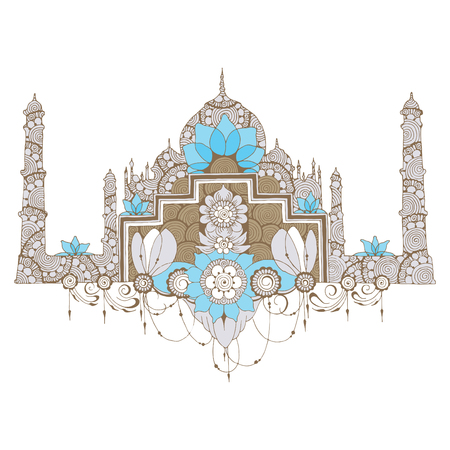The Timeless Beauty of Indian Mirror Work and Embroidery
Indian mirror work, also known locally as shisha, and intricate embroidery are treasured crafts that have adorned homes for centuries, lending a unique charm to stylish interiors. Rooted deeply in the cultural fabric of India, particularly in vibrant regions like Gujarat and Rajasthan, these techniques reflect a rich heritage passed down through generations. Shisha embroidery originated as a way to bring light and positive energy into homes, with tiny mirrors carefully stitched onto fabrics to catch the sun’s rays—a tradition believed to ward off negativity. Paired with detailed embroidery featuring motifs inspired by nature, folklore, and everyday village life, these crafts not only beautify textiles but also narrate stories of India’s diverse communities. Today, mirror work and embroidery continue to hold an important place in Indian décor, seamlessly blending tradition with contemporary tastes to create interiors that are both elegant and evocative of India’s artistic legacy.
Popular Styles and Regional Inspirations
India’s rich tradition of mirror work and embroidery reflects the country’s immense cultural diversity, with each state offering its own unique flair. From the vibrant deserts of Rajasthan to the lush landscapes of Gujarat and beyond, these crafts tell stories through intricate patterns and age-old techniques.
Distinctive Patterns and Motifs Across Regions
Each region in India has developed its own signature style when it comes to mirror work and embroidery, making every piece a celebration of local artistry. These regional differences are rooted in centuries-old traditions, often inspired by nature, folklore, and daily life. Here is a look at some popular styles:
| Region | Signature Style | Common Motifs | Main Techniques |
|---|---|---|---|
| Gujarat (Kutch) | Shisha (mirror) embroidery | Geometric shapes, flowers, peacocks | Hand-stitched mirrors set into colorful threads |
| Rajasthan | Jat embroidery and Gota Patti work | Floral vines, paisleys, desert scenes | Zari work, metallic embellishments, appliqué mirrors |
| Punjab | Phulkari embroidery | Bouquets, diamond patterns, wheat stalks | Darn stitching with vivid silk threads |
| Madhya Pradesh | Zardozi embroidery with mirrors | Royal patterns, animals, peacocks | Gold and silver threadwork combined with mirrors |
| Karnataka & Andhra Pradesh | Lambani tribal embroidery | Circular mirrors, coins, bold geometric motifs | Patches with hand-applied mirrors and beads |
The Allure of Authenticity in Home Décor
When you bring these regional treasures into your home décor—be it through cushion covers adorned with Kutch shisha work or wall hangings featuring Phulkari—you’re not just adding colour and texture. You’re inviting an authentic slice of Indian heritage into your living space. Each piece holds stories from artisans’ lives and their communities, lending both warmth and character to modern interiors.
Blending Tradition with Modern Style
The beauty of Indian mirror work and embroidery lies in its adaptability. Whether you prefer a minimalist setting or a more eclectic look, these crafts can be incorporated as statement pieces or subtle accents. Mixing traditional patterns with contemporary design elements creates spaces that feel both rooted and refreshing—a true reflection of modern Indian living.

3. Incorporating Mirror Work and Embroidery into Modern Homes
Bringing the charm of Indian mirror work and intricate embroidery into contemporary homes is easier than you might think. These timeless crafts blend effortlessly with modern décor, adding vibrant pops of colour and a sense of warmth to your living spaces. Here are some practical tips on how to style accent pieces like cushion covers, wall hangings, and table runners for a stunning yet homely look.
Cushion Covers: Adding Lively Textures
Embroidered and mirror work cushion covers can instantly uplift a neutral sofa or bed. For a balanced look, pair one or two statement cushions with solid-coloured ones. Choose bright hues like rani pink, royal blue, or mustard yellow to reflect an authentic Indian vibe while keeping the rest of the room subtle. Mixing geometric patterns with floral motifs can add visual interest without overwhelming the space.
Wall Hangings: Creating a Focal Point
Handcrafted wall hangings featuring mirror work and embroidery make for striking focal points in living rooms, entryways, or bedrooms. Opt for large pieces above sofas or beds, or create a gallery wall using smaller embroidered panels. To maintain a modern aesthetic, display these hangings in sleek wooden or metallic frames that complement your existing décor. Don’t hesitate to experiment by layering different sizes and shapes for an eclectic yet curated feel.
Table Runners: Infusing Dining Areas with Heritage
A beautifully embroidered table runner with delicate mirror accents can transform your dining area from ordinary to festive. Choose designs that echo the colour palette of your crockery or overall dining room theme. For daily use, go for durable fabrics like cotton with minimal embellishments; reserve more ornate silk or velvet runners for special occasions such as Diwali gatherings or family get-togethers.
By thoughtfully integrating these handcrafted elements into your home, you not only celebrate traditional Indian artistry but also create a welcoming atmosphere full of character and joy. With just a few accent pieces, it’s possible to honour heritage while embracing contemporary living—making every corner of your home uniquely yours.
4. Where to Find Home Décor with Indian Embroidery
If you are inspired by the elegance of Indian mirror work and embroidery, finding authentic décor pieces is the next step in transforming your living space. India’s vast heritage is reflected in its marketplaces, artisan collectives, and a growing number of online platforms that bring these traditional crafts right to your doorstep. Here’s a practical guide to sourcing genuine mirror work and embroidered home décor:
Local Handicraft Bazaars and Exhibitions
For those who love to experience culture firsthand, visiting local bazaars such as Dilli Haat (Delhi), Johari Bazaar (Jaipur), or Law Garden Night Market (Ahmedabad) can be an exciting way to discover unique pieces. These markets are treasure troves of handcrafted textiles, wall hangings, cushion covers, and table runners adorned with intricate mirror work and embroidery. Don’t hesitate to ask the artisans about their techniques and stories—it adds personal value to each piece.
Online Platforms
With the rise of e-commerce in India, it’s easier than ever to access regional crafts from anywhere in the country—or even abroad. Leading online platforms offer curated collections from various states, ensuring authenticity and quality. Here’s a comparison table of popular options:
| Platform | Specialty | Shipping Coverage |
|---|---|---|
| Jaypore | Handcrafted textiles & home décor | India & International |
| Craftsvilla | Traditional mirror work & embroidery items | India wide |
| Gaatha | Artisan-sourced decor from rural clusters | India & selected international locations |
| Etsy India Sellers | Bespoke, custom-made pieces | Global shipping options available |
Supporting Rural Artisans and Sustainable Brands
If you wish to make a positive impact while decorating your home, consider buying directly from NGOs or brands that empower rural artisans. Organizations like Dastkar, Kala Raksha, and Sadhna collaborate with women’s cooperatives and artisan groups across Gujarat, Rajasthan, and Kutch—regions renowned for their vibrant embroidery traditions. Purchasing through these channels not only ensures authenticity but also supports sustainable livelihoods.
Tips for Authenticity and Ethical Sourcing:
- Ask for Geographical Indication (GI) tags: Many Indian crafts have GI tags certifying their origin.
- Look for artisan stories: Genuine sellers often share details about the makers and their communities.
- Avoid mass-produced imitations: Authentic pieces are usually slightly irregular, reflecting handwork.
- Inquire about sustainable practices: Choose brands committed to fair trade and eco-friendly processes.
Sourcing Indian mirror work and embroidery décor is more than just shopping—it’s an opportunity to connect with centuries-old traditions while supporting the hands that keep them alive. Whether you visit a bustling bazaar or browse thoughtfully online, let your choices reflect both style and heart.
5. Caring for Your Mirror Work and Embroidered Pieces
Indian mirror work and embroidery are treasured not only for their beauty but also for the skilled craftsmanship behind each piece. To ensure your home décor remains vibrant and stunning across generations, mindful care is essential. Here are some simple and effective tips to help you maintain these exquisite textiles:
Regular Dusting and Gentle Cleaning
Dust can easily accumulate on decorative fabrics, especially those adorned with mirrors or intricate stitches. Use a soft, dry cloth or a gentle brush to remove dust from surfaces weekly. For deeper cleaning, hand wash with cold water and mild detergent. Avoid wringing or scrubbing to protect delicate threads and mirrors.
Avoid Direct Sunlight and Moisture
Prolonged exposure to direct sunlight can cause colours to fade, while moisture may lead to mildew or tarnish the mirrors. Place your embroidered pieces in shaded areas away from windows, and always keep them dry. If you live in humid regions like Kerala or Goa, consider silica gel packets to absorb excess moisture.
Proper Storage Solutions
When not in use, store your mirror work textiles flat or rolled, rather than folded, to prevent creasing and breakage of mirrors. Wrap them in soft cotton cloths—never plastic—to allow air circulation. This traditional method helps preserve both the fabric’s integrity and its cultural value.
Professional Restoration and Repairs
If you notice loose threads, missing mirrors, or other damage, consult a local artisan skilled in Indian embroidery techniques for repair. Many cities across India have markets where expert craftspeople offer restoration services, ensuring your cherished décor stays beautiful for years.
Handcrafted Legacy for Generations
Caring for your Indian mirror work and embroidery is about more than just maintenance—it’s about honouring tradition and preserving artistry for future generations. With thoughtful attention, your handcrafted home décor will continue to add a touch of Indian elegance and warmth to your interiors for many years to come.
6. Embracing Indian Roots in Everyday Living
Incorporating Indian mirror work and embroidery into your home décor is not just about creating a visually stunning interior—it is a heartfelt way to honour our rich cultural legacy every day. Traditionally, intricate embroidery and sparkling mirror accents have adorned our homes during festivals and special occasions, filling spaces with joy and vibrancy. However, these crafts are much more than occasional embellishments; they are an expression of Indian artistry that can enrich daily living.
Choosing cushion covers with hand-embroidered motifs, wall hangings decorated with glimmering mirrors, or even table runners featuring regional stitches like Kantha or Phulkari brings warmth and authenticity to your interiors. These pieces are lovingly crafted by skilled artisans whose techniques have been handed down through generations—making each item a symbol of family heritage and community pride.
By weaving these traditional elements into your everyday spaces, you celebrate the creativity and resilience of Indian craftsmanship beyond Diwali or weddings. It becomes a style statement that is uniquely yours, telling a story of roots, memories, and values through design. Let your living room, bedroom, or dining area reflect the vibrant colours and textures of India, inspiring conversations and connections within your family and among friends.
Embracing such décor also supports local artisans and sustains age-old traditions. Whenever you choose a piece handcrafted with love from Gujarat’s mirror work or Rajasthan’s embroidery, you are helping preserve these art forms for future generations. This mindful approach transforms your home into a living gallery where tradition meets modern comfort—making every day feel special.
So go ahead, mix vintage embroidered textiles with contemporary furniture or pair bold mirrorwork accents with subtle backgrounds. Allow your home to become a canvas that honours your roots while staying stylishly current. Celebrate Indian craftsmanship not just for festive moments but as a daily tribute to your heritage—a reminder that beauty, meaning, and tradition belong in the heart of everyday life.


